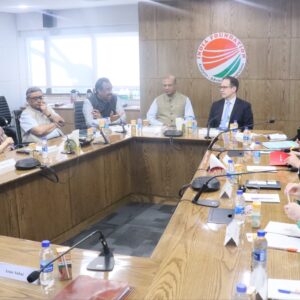~ By Shakti Sinha
The attack on the Afghan parliament reflects the deteriorating security situation in that country. The withdrawal of foreign troops and strategic choices made by President Ghani seem to have emboldened the Taliban who have now started capturing territory and holding on to them, a change from their earlier tactics of inflicting damage and creating insecurity in the countryside. No doubt, the Afghan security forces are holding on, repulsing the attack on Parliament killing all attackers but their ability to ensure security and stability is questionable.
The Taliban offensive is clear from the figures of civilian casualties in the first three months of 2015, where anti-government forces were responsible for 73 percent of all casualties. Though the total casualties are up eight percent compared to last year, the civilian casualties from mortar and rocket fire have gone up by 43 percent to 266 (62 deaths, 204 injuries). In earlier years, IEDs and suicide bombs were overwhelming responsible for all civilian deaths. Clearly the Taliban have now emerged as a battle-field fighting force. Targeted assassinations are also on the rise undercutting government’s credibility and creating fear in the minds of the Taliban’s enemies.
President Ashraf Ghani came to power as a result of compromise brokered between him and Dr Abdullah, now his chief executive, by the US which broke the deadlock caused by the inconclusive elections marred by allegations of large scale irregularities. Once the agreement was reached, the Election Commission declared Dr Ghani the winner but till date final voting figures have not been released. The circumstances leading to, and the actual formation of this unusual governing arrangement, which goes beyond Constitutional provisions are factors responsible for the political quagmire looming over Afghanistan. The government has not had a smooth sailing, and had great difficulty first in agreeing on names of ministers, and then getting parliament to ratify its nominations. In fact, the crucial post of defence minister has been vacant for nine months, with two ‘failed’ nominees. The Taliban timed the parliament attack to coincide with second Vice President Sarwar Danish’s introduction to parliament of Masoom Stanekzai as the defence minister nominee.
President Ghani’s unexpected approach to Pakistan, through China and directly, was recognised as a high risk strategy. Ghani’s correct assumption was that there can be no peace in Afghanistan unless the Pakistan army was on board, but whether they can be won over is the question. The Pak army are seen alternatively as controlling the Taliban, using them as their ‘strategic asset’, or having leverage over them. And Ghani rightly assessed that only the Chinese have leverage over the Pakistan army. The Afghan government handed over anti-Pak army elements, who had been given shelter earlier. Army-to-army links at the Corp commanders’ level, coordinated patrols and operations, deputing Afghan military cadets for training in Pakistan etc have been operationalised. Recently, ISI and the Afghan intelligence agency (NDS) have signed an agreement to carry out joint counter-terrorists operations and for the training of NDS personnel in Pakistan though the NDS chief opposed the agreement. Perhaps few believed that the ISI will keep its end of the bargain. In fact, the Afghan intelligence spokesperson, Hassib Sediqqi, said that an ISI officer helped the Haqqani network, a Taliban affiliate, carry out the attack on parliament. According to him, the suicide car bomb was manufactured in Peshawar, and the NDS were aware of the impending attack as early as June 10th. Consequently they had beefed up security arrangements at the complex.
Despite such unilateral concessions by Afghanistan, there has been no peace dividend. Far from the Taliban ceasing attacks and coming over-ground to engage with the Afghan government, it has in fact stepped up its attacks. The Taliban have made a show of consulting with foreign governments, Afghan civil society etc., it has singularly refused to respond to the Afghan government’s offer for talks. Instead, recently they seized that strategically important Musa Qala district of North Helmand. Over the last week, after surrounding Afghan security forces, they have taken control over two districts in Kunduz province – Chardara and Dasht-i-Archi.
Besides, there are also reports of the emergence of the Islamic State (IS) in Afghanistan. The first reports that emerged in mid-2014 from Ghazni turned out to be false, but subsequently there have been a number of reports that disaffected Afghan insurgents have aligned with the IS, along with a number of Pakistani Taliban. Reportedly there have been a number of clashes between the Taliban and IS, though there could be a tendency to overestimate the latter’s strength. Many local government security chiefs cite the IS threat to be able to garner more resources, and small time ‘warlords’ claim allegiance to IS in order to increase their profile. Overall, the Taliban is too pervasive to allow the IS much space.
If these developments were not confusing enough, evidence is surfacing about an informal alliance between the Taliban and their former enemies, Iran. This is not the first time that Iran has supplied arms and ammunitions to the Taliban, against their common enemy, earlier the US and now, the IS. This tactical alliance is an act of brinkmanship, reflecting the extent to which different parties are prepared to go.
Constitutionally, Afghanistan faces a crisis. Parliament’s term is over but in the prevailing situation, elections are not possible. President Ghani has extended its term but is on shaky legal grounds. Inability to form a functional government for months led to paralysis in governance and severely tested the credibility of the agreement underpinning the government. Even at present the Supreme Court, the Attorney General’s office and the Constitutional Oversight Commission have acting heads. This inability to govern could easily morph into a test not just of credibility but of legitimacy, with questions being asked about the legality of the executive and the legislature, and even of the judiciary.
A deteriorating security environment, weakening economy as a result of draw down of development assistance and governance breakdown does not bode well for Afghanistan as well as its neighbourhood. Ghani’s gambit of trying to involve China to help stabilise seems dangerously close to failure. The question remains that were Afghanistan to implode, will its effects be limited to within its borders, or would it push the unravelling of its eastern neighbour?
What are India’s options? It cannot be seen opposing the Afghan outreach to Pakistan, lest it be seen as a spoiler, something Pakistan would be quick to pounce upon. For the outreach to succeed, unlikely as it seems, the Pak army would have to re-orient itself away from interfering in its neighbours or of using jihadis as strategic assets; a development India can only welcome. Meanwhile, India must strengthen its dialogue with all sections of Afghan society, using its development assistance in a transparent manner to maintain its reputation as a friend of the country. India represents a successful political and economic model and its importance as a reliable partner would override temporary setbacks. Meanwhile India should prepare for an implosion of Pakistan that should not be allowed to spiral out of control.
Shakti Sinha is Director, South Asian Institute for Strategic Affairs (SAISA), New Delhi. The views expressed are his own.



